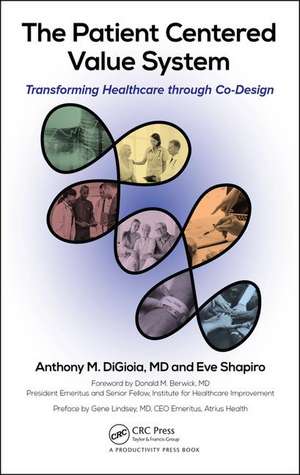The Patient Centered Value System: Transforming Healthcare through Co-Design
Autor Anthony M. DiGioia, Eve Shapiroen Limba Engleză Hardback – 6 sep 2017
Like most healthcare leaders, you are also still searching for a way to deliver care that will help you to achieve the Triple Aim: care that leads to improved clinical outcomes, better patient and family care experiences, and reduced costs.
Sound familiar? If so, then it’s time to read The Patient Centered Value System: Transforming Healthcare through Co-Design. This book explains how to introduce the Patient Centered Value System in your organization to go from the current state to the ideal.
The Patient Centered Value System is a three-part approach to co-designing improvements in healthcare delivery—collaborating with patients, families, and frontline providers to design the ideal state of care after listening to their wants and needs. Central to the Patient Centered Value System is seeing every care experience through the eyes of patients and families.
The Patient Centered Value System is a process and performance improvement technique that consists of 1) Shadowing, 2) the Patient and Family Centered Care Methodology, and 3) Time-Driven Activity-Based Costing. Shadowing is the essential tool in the Patient Centered Value System that helps you to see every care experience from the point of view of patients and families and enables you to calculate the true costs of healthcare over the full cycle of care.
Fundamental to the Patient Centered Value System is the building of teams to take you from the currents state of care delivery to the ideal. Healthcare transformation depends not on individual providers working to fix broken systems, but on teams of providers working together while breaking down silos.
The results of using the Patient Centered Value System are patients and families who are actively engaged in their care, which also improves their outcomes; providers who see the care experience from the patient’s and family’s point of view and co-design care delivery as a result; the tight integration of clinical and financial performance; and the realization of the Triple Aim.
| Toate formatele și edițiile | Preț | Express |
|---|---|---|
| Paperback (1) | 218.82 lei 6-8 săpt. | |
| Taylor & Francis – 18 dec 2020 | 218.82 lei 6-8 săpt. | |
| Hardback (1) | 288.63 lei 6-8 săpt. | |
| Taylor & Francis – 6 sep 2017 | 288.63 lei 6-8 săpt. |
Preț: 288.63 lei
Preț vechi: 334.90 lei
-14% Nou
Puncte Express: 433
Preț estimativ în valută:
55.24€ • 57.06$ • 45.97£
55.24€ • 57.06$ • 45.97£
Carte tipărită la comandă
Livrare economică 26 martie-09 aprilie
Preluare comenzi: 021 569.72.76
Specificații
ISBN-13: 9781138055964
ISBN-10: 1138055964
Pagini: 312
Ilustrații: Eight-page color insert; 17 Line drawings, black and white; 2 Halftones, black and white; 1 Tables, black and white; 17 Illustrations, black and white
Dimensiuni: 156 x 234 x 23 mm
Greutate: 1.25 kg
Ediția:1
Editura: Taylor & Francis
Colecția Productivity Press
Locul publicării:Oxford, United Kingdom
ISBN-10: 1138055964
Pagini: 312
Ilustrații: Eight-page color insert; 17 Line drawings, black and white; 2 Halftones, black and white; 1 Tables, black and white; 17 Illustrations, black and white
Dimensiuni: 156 x 234 x 23 mm
Greutate: 1.25 kg
Ediția:1
Editura: Taylor & Francis
Colecția Productivity Press
Locul publicării:Oxford, United Kingdom
Public țintă
Professional and Professional Practice & DevelopmentCuprins
Introduction: The Patient Centered Value System: Toward a New Age in Healthcare; Part 1: The Patient Centered Value System in Action: A Story; Chapter 1: How to introduce the Patient Centered Value System in any organization; Chapter 2: Choose your champions: Establish the care experience guiding council; Chapter 3: Shadow patients and families to co-design the care experience; Chapter 4: Develop your care experience working group; Chapter 5: Create a shared vision by writing the story of the ideal care experience; Chapter 6: Close the gaps between the current state and the ideal; Part 2: The Patient Centered Value System in Fact and in Practice; Chapter 7: The Patient Centered Value System: Fact, not fiction; Chapter 8: The true cost methodology of the Patient Centered Value System: A User’s Manual; Chapter 9: The Science behind the Patient Centered Value System: Built on the shoulders of giants.; Chapter 10: Patient Centered Value System + Lean or other process improvement approaches = Rapid Improvement; Chapter 11: The Patient Centered Value System in Practice; Chapter 12: Conclusion; Appendix 1: Glossary; Appendix 2: The Appendix explains what’s needed to assure success of the PCVS, why projects sometimes fail, how to get back on track, and the 65+ care experiences within UPMC that have been improved by use of the PCVS.
Recenzii
"The spiraling costs of healthcare and diminishing value for organizations, patients, and families requires a new, transformative approach to healthcare delivery. The Patient Centered Value System is the answer to lowering costs, improving clinical outcomes, and increasing the patient and family care experience. The PCVS has resulted in tangible improvements on all levels at the Connecticut Joint Replacement Institute at Saint Francis Hospital."
-Steve F. Schutzer, M.D., Medical Director, Connecticut Joint Replacement Institute, President, Connecticut Joint Replacement Surgeons, LLC
"The Patient Centered Value System: Transforming Care through Co-Design offers a highly readable and practical approach for dramatically improving patient outcomes and experiences. As health care consumers, we would definitely want our providers to be following the Patient Centered Value System principles, delivering high-quality, empathetic, and lower-cost patient care."
-Robert S. Kaplan, Marvin Bower Professor of Leadership Development, Emeritus at the Harvard Business School
"This book captures perfectly the challenge that faces quality improvers everywhere: that lasting change can only be achieved through a change in mindset which places patients and families at the centre of the improvement agenda. The Patient Centered Value System is one of the few approaches which does just this. This system works. What it also does is transform the working lives of the staff applying it, reconnecting them powerfully with their core mission to care. It has been a privilege to use this approach with teams from around the United Kingdom, and a joy to see the changes they make when they see care through patients’ eyes."
-Bev Fitzsimons, Head of Improvement, Point of Care Foundation, U.K.
"DiGioia and Shapiro have achieved the goal of every author: to make understandable that which is complex, and to make implementable complex principles. When the subject is patient (and family)-centered care, those goals are both formidable and critical to the nation’s health."
-John R. Ball, M.D., J.D, Executive Vice President, Emeritus, American College of Physicians
"This book will teach you how to see. Whether you are a hospital CEO, as I have been, or a care giver at the front lines of care, as I have been, this book will open your eyes to the journey of a patient and family throughout care. The care systems of the future will be designed with and for our patients and their families. This book is the best guide to give you the tools and methods to co-design care with them."
-Maureen Bisognano, President Emerita and Senior Fellow, Institute for Healthcare Improvement
"...the Patient Centered Value System is based on the natural curiosity and good intentions of clinicians and is designed to capture what’s really going on in the hospitals. Transformative? We’ll see. But it’s the best I’ve seen in a long time."
-Paul F. Levy is former CEO of Beth Israel Deaconess Medical Center, Boston (2002-2011).
-Steve F. Schutzer, M.D., Medical Director, Connecticut Joint Replacement Institute, President, Connecticut Joint Replacement Surgeons, LLC
"The Patient Centered Value System: Transforming Care through Co-Design offers a highly readable and practical approach for dramatically improving patient outcomes and experiences. As health care consumers, we would definitely want our providers to be following the Patient Centered Value System principles, delivering high-quality, empathetic, and lower-cost patient care."
-Robert S. Kaplan, Marvin Bower Professor of Leadership Development, Emeritus at the Harvard Business School
"This book captures perfectly the challenge that faces quality improvers everywhere: that lasting change can only be achieved through a change in mindset which places patients and families at the centre of the improvement agenda. The Patient Centered Value System is one of the few approaches which does just this. This system works. What it also does is transform the working lives of the staff applying it, reconnecting them powerfully with their core mission to care. It has been a privilege to use this approach with teams from around the United Kingdom, and a joy to see the changes they make when they see care through patients’ eyes."
-Bev Fitzsimons, Head of Improvement, Point of Care Foundation, U.K.
"DiGioia and Shapiro have achieved the goal of every author: to make understandable that which is complex, and to make implementable complex principles. When the subject is patient (and family)-centered care, those goals are both formidable and critical to the nation’s health."
-John R. Ball, M.D., J.D, Executive Vice President, Emeritus, American College of Physicians
"This book will teach you how to see. Whether you are a hospital CEO, as I have been, or a care giver at the front lines of care, as I have been, this book will open your eyes to the journey of a patient and family throughout care. The care systems of the future will be designed with and for our patients and their families. This book is the best guide to give you the tools and methods to co-design care with them."
-Maureen Bisognano, President Emerita and Senior Fellow, Institute for Healthcare Improvement
"...the Patient Centered Value System is based on the natural curiosity and good intentions of clinicians and is designed to capture what’s really going on in the hospitals. Transformative? We’ll see. But it’s the best I’ve seen in a long time."
-Paul F. Levy is former CEO of Beth Israel Deaconess Medical Center, Boston (2002-2011).
Descriere
The Patient Centered Value System is a three-part approach to co-designing improvements in healthcare delivery—collaborating with patients, families, and frontline providers to design the ideal state of care after listening to their wants and needs. Central to the Patient Centered Value System is seeing through the eyes of patients and families.
Notă biografică
Anthony M. DiGioia, III, MD, creator of the Patient Centered Value System, is a practicing orthopeadic surgeon and medical director of both the Bone and Joint Center and Innovation Center at the University of Pittsburgh Medical Center (UPMC). Tony graduated from Carnegie Mellon University in Civil Engineering, obtained a graduate degree in Civil and Biomedical Engineering, and then attended Harvard Medical School, completed his orthopaedic residency in Pittsburgh, and a Fellowship at Massachusetts General Hospital. Wanting to help bridge the gap between engineering and medicine, Tony was a world leader in the initial development of medical robotics and computer assisted surgery. His work has always focused on bringing together diverse teams from multiple disciplines in order to listen to and meet the needs of patients and families. This broad focus led Tony to develop the Patient Centered Value System, which combines process and performance improvement with supportive technologies to improve clinical outcomes and patient and family care experiences while reducing costs.
Eve Shapiro, principal, Eve Shapiro Medical Writing, Inc., has written on topics related to patient safety, patient-centered care, systems improvement, transitions in care, physician-patient communication, medical errors, and other subjects for audiences ranging from researchers and clinicians to patients and families. She has written books, articles, and other works for organizations such as the Agency for Healthcare Research and Quality, the Institute for Healthcare Improvement, The Joint Commission, the Robert Wood Johnson Foundation, the University of Pittsburgh Medical Center, and Consumers Advancing Patient Safety. Eve believes storytelling is the most powerful way to teach, generate insight, promote understanding, and communicate essential truths.
Eve Shapiro, principal, Eve Shapiro Medical Writing, Inc., has written on topics related to patient safety, patient-centered care, systems improvement, transitions in care, physician-patient communication, medical errors, and other subjects for audiences ranging from researchers and clinicians to patients and families. She has written books, articles, and other works for organizations such as the Agency for Healthcare Research and Quality, the Institute for Healthcare Improvement, The Joint Commission, the Robert Wood Johnson Foundation, the University of Pittsburgh Medical Center, and Consumers Advancing Patient Safety. Eve believes storytelling is the most powerful way to teach, generate insight, promote understanding, and communicate essential truths.













